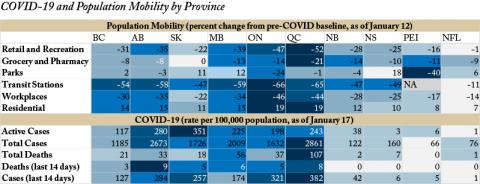From: Rosalie Wyonch
To: Canadian COVID Watchers
Date: January 20, 2021
Re: Going Hard and Staying Home: COVID-19 Surge and Mobility Restrictions
New restrictions on movement are the main feature of the latest provincial lockdowns as COVID-19 advances with unprecedented speed. But mobility data shows that additional measures might be needed in some provinces, while provinces already under severe restrictions may require additional tools to manage the pandemic.
There have been more than 100,000 new cases of COVID-19 in Canada in the past two weeks, about 15 percent of all cases since the beginning of the pandemic. As of Sunday, the pandemic had claimed the lives of 18,000 people with more than 10 percent of those deaths occurring in the past two weeks.
Quebec’s four-week lockdown began January 9 and includes an 8 p.m. curfew, but permits elementary classrooms to re-open; Ontario’s second provincial emergency started January 14, with new measures empowering all provincial offences officers to enforce the restrictions. Alberta and Saskatchewan have extended existing restrictions until near the end of January. British Columbia, with fewer new and total cases than other large provinces, still permits restaurants, bars and retail establishments to operate at reduced capacity.
The most recent data on population mobility shows that even before the most recent restrictions, people in Quebec and Ontario were already making fewer visits to workplaces, transit stations, retail and recreational establishments and spending 19 percent more time in their homes (See Figure). That means, however, the new restriction limiting mobility, though necessary, will likely not be enough to manage the spread of COVID-19 on their own.
Saskatchewan, which has both the highest case rate and weaker restrictions, could benefit in particular from trying to limit mobility.
The recent surge in COVID-19 cases has resulted in broader restrictions than the first wave in many regions. Provinces that have maintained the previous levels of restriction may need to increase them to manage the spread of infection, as a result of recent growth in cases. While reducing physical contacts as much as possible is of critical importance, increasing the effectiveness of contact tracing and case isolation, as well as reducing transmission where physical proximity does occur (through physical barriers, increased mask-wearing, improved ventilation in congregant environments and other means) will also be necessary to effectively control the spread of COVID-19.
Rosalie Wyonch is a Senior Policy Analyst at the C.D. Howe Institute.
To send a comment or leave feedback, email us at blog@cdhowe.org.
The views expressed here are those of the author. The C.D. Howe Institute does not take corporate positions on policy matters.
Note: Mobility data shows the percentage change in number of visits to locations other than residences. Mobility data for residences is the percentage change in number of hours
Source: Google LLC "Google COVID-19 Community Mobility Reports". Accessed: January 14. More information about mobility data available here
Government of Canada “Coronavirus disease 2019 (COVID-19): Epidemiology update”.






